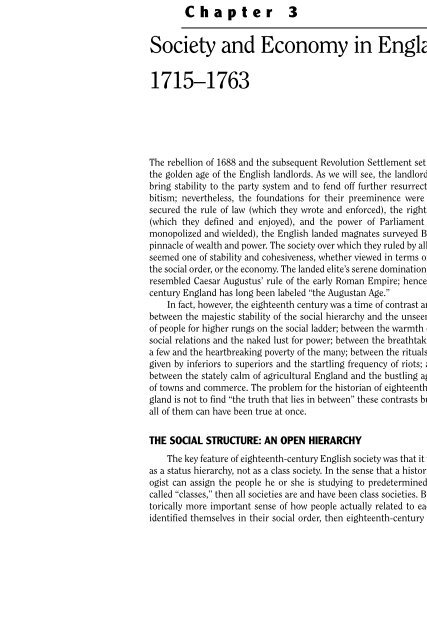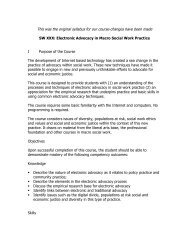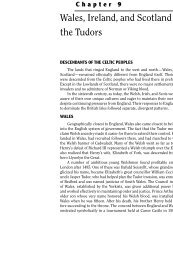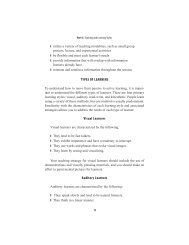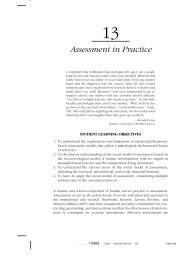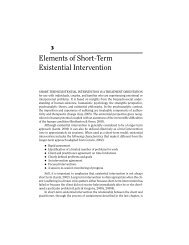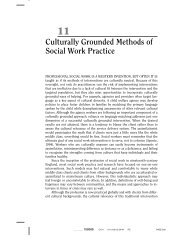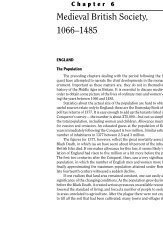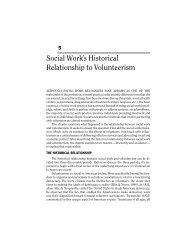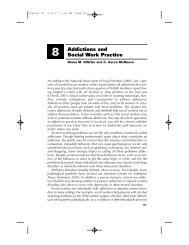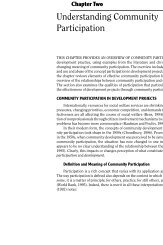Society and Economy in England, 1715–1763 - Lyceum Books
Society and Economy in England, 1715–1763 - Lyceum Books
Society and Economy in England, 1715–1763 - Lyceum Books
Create successful ePaper yourself
Turn your PDF publications into a flip-book with our unique Google optimized e-Paper software.
C h a p t e r 3<br />
<strong>Society</strong> <strong>and</strong> <strong>Economy</strong> <strong>in</strong> Engl<strong>and</strong>,<br />
<strong>1715–1763</strong><br />
The rebellion of 1688 <strong>and</strong> the subsequent Revolution Settlement set the stage for<br />
the golden age of the English l<strong>and</strong>lords. As we will see, the l<strong>and</strong>lords still had to<br />
br<strong>in</strong>g stability to the party system <strong>and</strong> to fend off further resurrections of Jacobitism;<br />
nevertheless, the foundations for their preem<strong>in</strong>ence were laid. Hav<strong>in</strong>g<br />
secured the rule of law (which they wrote <strong>and</strong> enforced), the rights of property<br />
(which they def<strong>in</strong>ed <strong>and</strong> enjoyed), <strong>and</strong> the power of Parliament (which they<br />
monopolized <strong>and</strong> wielded), the English l<strong>and</strong>ed magnates surveyed Brita<strong>in</strong> from a<br />
p<strong>in</strong>nacle of wealth <strong>and</strong> power. The society over which they ruled by all appearances<br />
seemed one of stability <strong>and</strong> cohesiveness, whether viewed <strong>in</strong> terms of the culture,<br />
the social order, or the economy. The l<strong>and</strong>ed elite’s serene dom<strong>in</strong>ation of the nation<br />
resembled Caesar Augustus’ rule of the early Roman Empire; hence, eighteenthcentury<br />
Engl<strong>and</strong> has long been labeled “the Augustan Age.”<br />
In fact, however, the eighteenth century was a time of contrast <strong>and</strong> paradox—<br />
between the majestic stability of the social hierarchy <strong>and</strong> the unseemly scramble<br />
of people for higher rungs on the social ladder; between the warmth of paternalist<br />
social relations <strong>and</strong> the naked lust for power; between the breathtak<strong>in</strong>g wealth of<br />
a few <strong>and</strong> the heartbreak<strong>in</strong>g poverty of the many; between the rituals of deference<br />
given by <strong>in</strong>feriors to superiors <strong>and</strong> the startl<strong>in</strong>g frequency of riots; <strong>and</strong> above all<br />
between the stately calm of agricultural Engl<strong>and</strong> <strong>and</strong> the bustl<strong>in</strong>g aggressiveness<br />
of towns <strong>and</strong> commerce. The problem for the historian of eighteenth-century Engl<strong>and</strong><br />
is not to f<strong>in</strong>d “the truth that lies <strong>in</strong> between” these contrasts but to see how<br />
all of them can have been true at once.<br />
THE SOCIAL STRUCTURE: AN OPEN HIERARCHY<br />
The key feature of eighteenth-century English society was that it was arranged<br />
as a status hierarchy, not as a class society. In the sense that a historian or sociologist<br />
can assign the people he or she is study<strong>in</strong>g to predeterm<strong>in</strong>ed pigeonholes<br />
called “classes,” then all societies are <strong>and</strong> have been class societies. But <strong>in</strong> the historically<br />
more important sense of how people actually related to each other <strong>and</strong><br />
identified themselves <strong>in</strong> their social order, then eighteenth-century English men
48 Part I The Age of the L<strong>and</strong>ed Oligarchy<br />
Mr <strong>and</strong> Mrs Andrews, by Thomas Ga<strong>in</strong>sborough (1748). This pa<strong>in</strong>t<strong>in</strong>g reflects the comfortable<br />
self-assurance of the English country gentry <strong>in</strong> the eighteenth century.<br />
<strong>and</strong> women ordered themselves <strong>in</strong> a status hierarchy. The basic sets of relationships<br />
should be envisioned as vertical, not horizontal. Each person was thought to have<br />
been ascribed at birth a position <strong>in</strong> the natural—<strong>in</strong>deed, div<strong>in</strong>ely established—<br />
peck<strong>in</strong>g order, <strong>and</strong> each felt that his or her loyalty was to social superiors, not to<br />
fellow workers. Hence the social structure was like a status ladder, or rather a number<br />
of parallel ladders, each rung be<strong>in</strong>g a status gradation with its own generally<br />
accepted duties <strong>and</strong> privileges. If a person moved up or down the ladder, it was off<br />
one rung <strong>and</strong> onto another, the ladder itself rema<strong>in</strong><strong>in</strong>g unchanged. Dr. Samuel<br />
Johnson, the great wit <strong>and</strong> man of letters, remarked that the English people were<br />
set <strong>in</strong> their hierarchical places “by the fixed, <strong>in</strong>variable rules of dist<strong>in</strong>ction of rank,<br />
which create no jealousy, s<strong>in</strong>ce they are held to be accidental.” Thus, when the English<br />
talked about social position, they spoke <strong>in</strong> terms of “degrees,” “order,” <strong>and</strong><br />
“ranks”—gradations of status, not of class.<br />
“Mank<strong>in</strong>d,” Dr. Johnson observed, “are happier <strong>in</strong> a state of <strong>in</strong>equality <strong>and</strong> subord<strong>in</strong>ation.”<br />
Such was the view unanimously held by those at the top of the hierarchy<br />
<strong>and</strong> ceaselessly preached to those below them. This is not surpris<strong>in</strong>g, s<strong>in</strong>ce the<br />
distance <strong>in</strong> wealth <strong>and</strong> prestige from top to bottom was enormous. On the highest<br />
rung of the hierarchy stood the titled nobility, consist<strong>in</strong>g of fewer than two hundred<br />
families. All the nobles were great l<strong>and</strong>lords who dom<strong>in</strong>ated their counties <strong>in</strong><br />
near-majestic splendor. They lived <strong>in</strong> palatial country homes, often gigantic edifices<br />
of close to one hundred rooms, <strong>and</strong> enjoyed on average £8,000 a year. A few, like the<br />
duke of Bedford <strong>and</strong> the duke of Devonshire, raked <strong>in</strong> more than £30,000 a year<br />
from rentals alone—the equivalent of many millions of dollars today. Just below<br />
the nobility came the ranks of the big l<strong>and</strong>lords—baronets, knights, esquires, <strong>and</strong>
Chapter 3 <strong>Society</strong> <strong>and</strong> <strong>Economy</strong> <strong>in</strong> Engl<strong>and</strong>, <strong>1715–1763</strong> 49<br />
gentlemen—more than fifteen thous<strong>and</strong> families, each enjoy<strong>in</strong>g upward of £1,000<br />
a year <strong>and</strong> each liv<strong>in</strong>g <strong>in</strong> a stately country house. Together, these l<strong>and</strong>lords <strong>and</strong><br />
their families—the nobility <strong>and</strong> the gentry—amounted to less than 3 percent of the<br />
population, but they enjoyed 15 percent of the national <strong>in</strong>come. All also enjoyed the<br />
vitally important status of “gentleman”—a position of honor, to be fought for if<br />
necessary, assigned to the lucky few born <strong>in</strong>to “good” families, <strong>and</strong> displayed by<br />
badges of status like genteel education, graceful deportment, <strong>and</strong> conspicuous consumption.<br />
Gentle status was def<strong>in</strong>ed as the ability to live well without work<strong>in</strong>g for<br />
a liv<strong>in</strong>g, or, as the novelist Daniel Defoe put it, gentlemen were “such who live on<br />
estates, <strong>and</strong> without the mechanism of employment.”<br />
In the countryside, below the gentlemen (<strong>and</strong> ladies) came those who actually<br />
worked the l<strong>and</strong>—freeholders, tenant farmers, <strong>and</strong> farm laborers. Freeholders were<br />
owner-occupiers, dist<strong>in</strong>guished from the gentry <strong>in</strong> that they managed their farms<br />
themselves. Freeholders still claimed the traditional label of “yeomen,” but this was<br />
a dw<strong>in</strong>dl<strong>in</strong>g order. Most farms were worked by tenants, some of them well-off, others<br />
struggl<strong>in</strong>g, all of whom leased l<strong>and</strong> from the l<strong>and</strong>lords for cash. Their access to<br />
a tenancy <strong>and</strong> the terms of their leases were normally set by custom, though some<br />
l<strong>and</strong>lords simply rented to the highest bidder. Together, the freeholders <strong>and</strong> farmers<br />
of Engl<strong>and</strong> numbered about 350,000 families, most earn<strong>in</strong>g between £40 <strong>and</strong><br />
£150 a year. They employed large numbers of farm laborers <strong>and</strong> domestic servants,<br />
who were themselves ranked <strong>in</strong> dist<strong>in</strong>ct hierarchies—husb<strong>and</strong>men, stableboys,<br />
milkmaids, housekeepers, cooks, butlers, gardeners, <strong>and</strong> scullery girls.<br />
Some of the farm laborers <strong>and</strong> domestics were hired on a yearly basis <strong>and</strong> “lived<br />
<strong>in</strong>” the farmer’s household. Most worked on a daily or seasonal hir<strong>in</strong>g, hav<strong>in</strong>g<br />
offered their labor for sale at a local market. The latter were the “cottagers,” who<br />
rented a cottage <strong>and</strong> a scrap of l<strong>and</strong> on which to grow vegetables, who usually had<br />
customary rights to the use of village commons <strong>and</strong> waste l<strong>and</strong>s, <strong>and</strong> who with<br />
their wives undertook some craft like weav<strong>in</strong>g, glove mak<strong>in</strong>g, or straw plait<strong>in</strong>g <strong>in</strong><br />
slack times. In good years, cottagers <strong>and</strong> their families could scrape together a meager<br />
liv<strong>in</strong>g; <strong>in</strong> bad years, they had to look to the parish for assistance. The lead<strong>in</strong>g<br />
statistician of the day made no dist<strong>in</strong>ction between “cottagers” <strong>and</strong> “paupers”—<br />
400,000 families with an average of only six or seven pounds a year. In rural Engl<strong>and</strong>,<br />
the laborers ranked above only those with no claim on the society at all—<br />
vagrants, beggars, thieves, <strong>and</strong> the like.<br />
The rural laborers formed part of the “labor<strong>in</strong>g poor”—the base of the social<br />
hierarchy that comprised almost a quarter of the population. The other segment of<br />
the labor<strong>in</strong>g poor lived <strong>in</strong> the towns. The urban labor<strong>in</strong>g poor, like those <strong>in</strong> the<br />
countryside, were often <strong>in</strong> need of assistance from the Poor Law or private charity;<br />
they <strong>in</strong>cluded vagrants, beggars, crim<strong>in</strong>als, soldiers, sailors, <strong>and</strong> unskilled male <strong>and</strong><br />
female workers.<br />
Above the urban labor<strong>in</strong>g poor came the wide range of the “middl<strong>in</strong>g sort,”<br />
who constituted a dynamic <strong>and</strong> grow<strong>in</strong>g element <strong>in</strong> English society, amount<strong>in</strong>g to<br />
about 15 percent of the English <strong>and</strong> Welsh population <strong>in</strong> the early seventeen hundreds.<br />
The middl<strong>in</strong>g sort did not fit neatly <strong>in</strong>to the traditional social hierarchy. At
50 Part I The Age of the L<strong>and</strong>ed Oligarchy<br />
the lower end of the middl<strong>in</strong>g scale stood artisans, shopkeepers, tradesmen, <strong>and</strong><br />
their families, earn<strong>in</strong>g perhaps £50 a year. Artisans had their own hierarchies:<br />
apprentices, journeymen, <strong>and</strong> masters, most of whom were male, though women<br />
sometimes did become apprentices <strong>and</strong> learned the trades. Some master artisans<br />
owned their own shops <strong>and</strong> employed apprentices <strong>and</strong> journeymen. The London<br />
Tradesman <strong>in</strong> 1747 listed more than 350 different crafts <strong>and</strong> trades: butchers, bakers,<br />
<strong>and</strong> c<strong>and</strong>lestickmakers; but also jewelers, goldsmiths, shipwights, carpenters,<br />
jo<strong>in</strong>ers, shoemakers, saddlers, harnessmakers, tailors, lacemakers, weavers, cutlers,<br />
pr<strong>in</strong>ters, cha<strong>in</strong>makers, spurriers, gunsmiths, hatters, clockmakers, <strong>and</strong> all the rest<br />
of a world of manufactur<strong>in</strong>g now largely gone.<br />
Above the artisans <strong>and</strong> shopkeepers <strong>in</strong> <strong>in</strong>comes <strong>and</strong> st<strong>and</strong>ards of liv<strong>in</strong>g were<br />
the merchants <strong>and</strong> professional people. Rich bus<strong>in</strong>essmen could earn anyth<strong>in</strong>g<br />
from hundreds to thous<strong>and</strong>s of pounds a year. Professional men—women could not<br />
enter any of the professions until the late n<strong>in</strong>eteenth century—<strong>in</strong>cluded clergymen,<br />
lawyers, <strong>and</strong> doctors; they earned a wide range of <strong>in</strong>comes <strong>and</strong> improved their<br />
status throughout the century. At the beg<strong>in</strong>n<strong>in</strong>g of the century, professional men<br />
were regarded, like tradesmen <strong>and</strong> merchants, as overly ambitious <strong>and</strong> therefore<br />
not genteel. By the end of the century, however, they had ga<strong>in</strong>ed considerable<br />
respectability <strong>and</strong> were even thought of as satellites of the l<strong>and</strong>ed orders. The middl<strong>in</strong>g<br />
sorts would eventually form the germ of the middle class, but <strong>in</strong> the eighteenth<br />
century their ma<strong>in</strong> desire was to make enough money to buy an estate <strong>and</strong><br />
jo<strong>in</strong> the elite circle of l<strong>and</strong>ed society.<br />
Eighteenth-century society, then, was a f<strong>in</strong>ely graded hierarchy <strong>in</strong> which status<br />
dist<strong>in</strong>ctions were carefully def<strong>in</strong>ed, observed, <strong>and</strong> protected. Yet Engl<strong>and</strong> was<br />
not a caste society. While there was little movement at the top level, the titled aristocracy,<br />
none of the rungs on the social ladder was legally closed to outsiders.<br />
L<strong>and</strong>owners enjoyed privileges, but the privileges def<strong>in</strong>ed by the law were surpris<strong>in</strong>gly<br />
few <strong>in</strong> number: the titled nobility sat <strong>in</strong> the House of Lords <strong>and</strong> were entitled<br />
to trial by their peers; otherwise, nobility <strong>and</strong> gentry were subject to the same body<br />
of law as everyone else <strong>and</strong> theoretically opened their ranks to newcomers. These<br />
concessions composed the social price that the l<strong>and</strong>owners paid for the preem<strong>in</strong>ence<br />
they won <strong>in</strong> 1688. In eighteenth-century Engl<strong>and</strong>, property determ<strong>in</strong>ed status,<br />
<strong>and</strong> property could be purchased. In medieval society, property followed status,<br />
but this rule had now been reversed. It was possible for a person to acquire a fortune,<br />
buy property, <strong>and</strong> move up to the appropriate rung on the social ladder. At the<br />
same time, it was possible for a family to squ<strong>and</strong>er its fortune <strong>and</strong> its estates <strong>and</strong><br />
thus to f<strong>in</strong>d itself reduced <strong>in</strong> status. Rich bus<strong>in</strong>essmen tried to marry daughters of<br />
the gentry so as to acquire status; younger sons of l<strong>and</strong>ed families often had to<br />
marry mercantile wealth or to f<strong>in</strong>d positions <strong>in</strong> the professions. In sum, there were<br />
numerous opportunities for social mobility <strong>in</strong> eighteenth-century Engl<strong>and</strong>.<br />
There was also an often unseemly scramble as people jostled for positions <strong>in</strong><br />
the social hierarchy. Barons sought to become earls, squires to become knights,<br />
farmers to become squires, merchants to become gentlemen, <strong>and</strong> shopkeepers to<br />
become merchants. Money was the key, <strong>and</strong> Englishmen impressed foreigners with
Chapter 3 <strong>Society</strong> <strong>and</strong> <strong>Economy</strong> <strong>in</strong> Engl<strong>and</strong>, <strong>1715–1763</strong> 51<br />
their love of money. The most significant aspect of the upward scramble was for<br />
wealthy merchants <strong>and</strong> f<strong>in</strong>anciers to buy estates <strong>and</strong> so cross the all-important l<strong>in</strong>e<br />
<strong>in</strong>to gentle status. The society was full of men who had achieved privileged status:<br />
Sir George Dashwood, a London brewer; Sir Josiah Child, a banker; <strong>and</strong> Sir George<br />
Wombwell, a merchant of the East India Company. The most famous example was<br />
Thomas (“Diamond”) Pitt, the son of an Anglican clergyman who became a sea capta<strong>in</strong>,<br />
an <strong>in</strong>terloper <strong>in</strong> the trade of the East India Company, <strong>and</strong> f<strong>in</strong>ally a merchant<br />
<strong>and</strong> governor <strong>in</strong> the Company—a poacher turned gamekeeper. Pitt made so much<br />
money <strong>in</strong> Indian trade that he was eventually able to buy more than ten estates <strong>in</strong><br />
Engl<strong>and</strong> <strong>and</strong> set himself up as a member of Parliament. His gr<strong>and</strong>son William<br />
became earl of Chatham. (Pitt also brought home from India a diamond of 410<br />
carats, which he later sold for £135,000.) Such bus<strong>in</strong>essmen usually lacked the<br />
social graces to be fully accepted by l<strong>and</strong>ed society, but one or two generations later<br />
the family passed as the genu<strong>in</strong>e article. As Defoe put it, “After a generation or two,<br />
the tradesmen’s children, or at least their gr<strong>and</strong>children, come to be as good gentlemen,<br />
statesmen, parliament men . . . bishops <strong>and</strong> noblemen as those of the highest<br />
<strong>and</strong> most ancient families.”<br />
The upward <strong>and</strong> downward flow of people did not destroy the status hierarchy<br />
but rather preserved it. Each person <strong>and</strong> family assumed the style, the duties, <strong>and</strong><br />
the privileges of their new position as they moved up the rungs. Social mobility<br />
thus provided a safety valve for the economic dynamism of the country. It marked<br />
off Engl<strong>and</strong> as very different from Wales, Irel<strong>and</strong>, <strong>and</strong> even Scotl<strong>and</strong>, where the<br />
social hierarchies were comparatively petrified. In Engl<strong>and</strong>, as long as everyone<br />
recognized <strong>and</strong> accepted the hierarchy itself <strong>and</strong> behaved accord<strong>in</strong>g to the prescribed<br />
forms <strong>and</strong> st<strong>and</strong>ards at each level, then the structure itself was stable.<br />
SOCIAL RELATIONS: PROPERTY, PATRONAGE, AND DEFERENCE<br />
Property was one of the pillars of eighteenth-century society because it provided<br />
a person or family with the means of survival, because it formed the basis of<br />
power, <strong>and</strong> most of all because it determ<strong>in</strong>ed social status. “The great <strong>and</strong> chief end<br />
. . . of men unit<strong>in</strong>g <strong>in</strong>to commonwealths, <strong>and</strong> putt<strong>in</strong>g themselves under government,”<br />
John Locke had written, “is the preservation of their property.” The central<br />
features of social relationships were closely related to property: patronage <strong>and</strong> deference.<br />
Property enabled a person to disburse patronage—gifts, jobs, appo<strong>in</strong>tments,<br />
contracts, favors—<strong>and</strong> the ability to act as a patron was the crucial measure<br />
of property <strong>and</strong> status. To be a great man or lady was to be able to dispense patronage<br />
to clients, called <strong>in</strong> that day one’s “friends” or “<strong>in</strong>terest.” From the recipient’s<br />
po<strong>in</strong>t of view, to have a niche <strong>in</strong> life, a means of survival <strong>and</strong> advancement, required<br />
be<strong>in</strong>g with<strong>in</strong> the circle of some patron’s friends. Accord<strong>in</strong>g to the essayist Joseph<br />
Addison, “To an honest m<strong>in</strong>d the best perquisites of place are the advantages it gives<br />
a man of do<strong>in</strong>g good”; by “do<strong>in</strong>g good” he meant be<strong>in</strong>g helpful to one’s friends.<br />
Patronage played <strong>in</strong> eighteenth-century Engl<strong>and</strong> the role that merit <strong>and</strong><br />
achievement play <strong>in</strong> modern societies. Almost all government offices, clerical (that
52 Part I The Age of the L<strong>and</strong>ed Oligarchy<br />
is, church) appo<strong>in</strong>tments, tenancies on l<strong>and</strong>ed estates, jobs for laborers, apprenticeships<br />
for boys, commissions for artists <strong>and</strong> architects, assignments for writers,<br />
military <strong>and</strong> naval posts, <strong>and</strong> the vast array of positions <strong>in</strong> domestic service were<br />
distributed by patronage. No one took entrance or civil service exams or had to<br />
show certificates of qualification. Furthermore, few looked on patronage as corruption,<br />
for it was simply the way that the political (as we will see), economic, <strong>and</strong><br />
social systems worked. Nor did English men <strong>and</strong> women believe that seek<strong>in</strong>g help<br />
from a patron was degrad<strong>in</strong>g or that receiv<strong>in</strong>g such help was unfair. Here is a prime<br />
example of an unashamed request for patronage: the archbishop of Tuam <strong>in</strong> the<br />
1740s wrote the duke of Newcastle on the death of the archbishop of Armagh: “The<br />
death of our late primate happen<strong>in</strong>g when I was at Dubl<strong>in</strong>, I am later than others<br />
<strong>in</strong> my application upon that event; but as the race is not to the swift . . . I hope it<br />
will not be too late for me to lay my small pretentions . . . before yr. Grace.” From<br />
the patron’s side, we have the word of Sir Robert Walpole, great l<strong>and</strong>owner <strong>and</strong><br />
politician, who declared that “while he was <strong>in</strong> employment, he had endeavoured to<br />
serve his friends <strong>and</strong> relations; than which, <strong>in</strong> his op<strong>in</strong>ion, noth<strong>in</strong>g was more reasonable,<br />
or more just.”<br />
In return for their patronage, patrons dem<strong>and</strong>ed deference, which <strong>in</strong>cluded<br />
postures of gratitude, loyalty, service, <strong>and</strong> obedience. If a man felt entitled to claim<br />
assistance from his superior, he also felt it right to defer to that patron’s op<strong>in</strong>ions<br />
<strong>and</strong> wishes. Laborers were expected to move aside <strong>and</strong> pull their forelocks when the<br />
l<strong>and</strong>lord or members of his family rode by; tenant farmers to vote the way the<br />
l<strong>and</strong>owner wished; sons <strong>and</strong> daughters to defer to their parents; artists to render<br />
their patrons (or even their patrons’ prize animals) beautiful <strong>in</strong> portraits; <strong>and</strong> clergymen<br />
to preach on the l<strong>in</strong>es preferred by their patrons. Deference was not<br />
regarded as servile, but as honorable. As one late seventeenth-century guide for<br />
husb<strong>and</strong>men put it: “A just fear <strong>and</strong> respect he must have for his l<strong>and</strong>lord, or the<br />
gentleman his neighbour, because God hath placed them above him, <strong>and</strong> he hath<br />
learnt [<strong>in</strong> the Fifth Comm<strong>and</strong>ment] that by the father he ought to honour is meant<br />
all his superiors.”<br />
There were plenty of occasions, as we will see, when deference broke down <strong>in</strong><br />
the eighteenth century, for people, even the common folk, also had a strong sense<br />
of traditional rights <strong>and</strong> privileges, <strong>and</strong> sometimes the sense of rights clashed with<br />
that of obligations. Nevertheless, patronage <strong>and</strong> deference, more than force, held<br />
the society together. This was made possible by the fact that people were connected<br />
to each other by face-to-face relationships up <strong>and</strong> down the social hierarchy. It<br />
would be a mistake to th<strong>in</strong>k of those personal relationships as necessarily lov<strong>in</strong>g or<br />
friendly. The relationship was harsh if the patron was unfair or abusive, a situation<br />
for which there was no end of opportunities. The connection between patron <strong>and</strong><br />
client was always unequal, <strong>and</strong> exploitation was an <strong>in</strong>evitable feature of such an<br />
<strong>in</strong>equalitarian society. To see the <strong>in</strong>egalitarian attitudes, one need only to look at<br />
the prevail<strong>in</strong>g view toward the poor. As one observer wrote toward the end of the<br />
century, “Poverty is . . . a most necessary <strong>and</strong> <strong>in</strong>dispensable <strong>in</strong>gredient <strong>in</strong> society,<br />
without which nations <strong>and</strong> communities could not exist <strong>in</strong> a state of civilization.”
When, however, a patron was moved, like the novelist Henry Field<strong>in</strong>g’s Squire Allworthy,<br />
by decency <strong>and</strong> generosity, <strong>and</strong> above all when a patron allowed himself or<br />
herself to be regulated by custom, then the face-to-face connections took on someth<strong>in</strong>g<br />
of the warmth <strong>and</strong> trust of paternal relationships.<br />
The face-to-face relationships could exist only because the “scale of life,” as<br />
Professor Harold Perk<strong>in</strong> called it, was small. As late as 1760, 75 to 80 percent of the<br />
6.5 million people <strong>in</strong> Engl<strong>and</strong> lived <strong>in</strong> villages or small towns. It rema<strong>in</strong>ed true that<br />
few people outside the elite ever traveled beyond the parish or the nearest market<br />
town. Few people ever saw more than several hundred others gathered at one<br />
time—church services, markets, fairs, <strong>and</strong> traditional celebrations at the manor<br />
house be<strong>in</strong>g the ma<strong>in</strong> occasions. Each of these moments re<strong>in</strong>forced the local community.<br />
In rural Engl<strong>and</strong>, everyone knew everyone else. Even the units of production<br />
were small. The greatest noble households may have numbered a hundred servants<br />
<strong>and</strong> laborers, but most farm households were much smaller. Even <strong>in</strong> the<br />
towns, most work was done <strong>in</strong> households by the master or journeyman, his wife<br />
<strong>and</strong> family, <strong>and</strong> his apprentices <strong>and</strong> laborers. A large shop consisted of fifteen to<br />
twenty people. Peter Laslett has written: “Time was when the whole of life went forward<br />
<strong>in</strong> the family, <strong>in</strong> a circle of loved, familiar faces, known <strong>and</strong> fondled objects all<br />
to human size.”* This observation perhaps sentimentalizes the small scale of life,<br />
but it touches on the very different quality of human relationships <strong>in</strong> pre<strong>in</strong>dustral<br />
Engl<strong>and</strong> from those of the modern world.<br />
LAND, MARRIAGE, PATRIARCHY, AND THE FAMILY<br />
Chapter 3 <strong>Society</strong> <strong>and</strong> <strong>Economy</strong> <strong>in</strong> Engl<strong>and</strong>, <strong>1715–1763</strong> 53<br />
L<strong>and</strong>ed property was the foundation of the social hierarchy. L<strong>and</strong> produced<br />
much of the nation’s wealth <strong>and</strong> gave employment to most of the labor<strong>in</strong>g force.<br />
L<strong>and</strong> was the source of prestige <strong>and</strong> therefore the key to status. To own an estate<br />
placed a man at the top of the social ladder <strong>and</strong> gave him political power. But the<br />
size of estates grew throughout the century, <strong>and</strong> the number of estates was small;<br />
hence l<strong>and</strong> was expensive, <strong>and</strong> <strong>in</strong>creas<strong>in</strong>gly so dur<strong>in</strong>g the century. Two features of<br />
the society followed from these facts: (1) there was severe competition among the<br />
wealthy to buy (or to add to) estates; <strong>and</strong> (2) the object of all l<strong>and</strong>owners was to keep<br />
their estates <strong>in</strong>tact.<br />
The l<strong>and</strong>owners used several devices for these purposes. The first was the pr<strong>in</strong>ciple<br />
of primogeniture, or <strong>in</strong>heritance of the property by the eldest son. Younger<br />
sons <strong>and</strong> daughters might be given a lump sum of money or an annuity, but the<br />
estate as a whole passed to the eldest son, or <strong>in</strong> the absence of a son, to the designated<br />
heir. L<strong>and</strong>owners did everyth<strong>in</strong>g possible to avoid <strong>and</strong> prevent sale of an<br />
estate or parts of it. Primogeniture was largely a matter of custom <strong>and</strong> operated <strong>in</strong><br />
law only when a property owner died without a will, which no competent l<strong>and</strong>owner<br />
would ever allow to happen. Hence the most important device for ensur<strong>in</strong>g<br />
the passage of an estate <strong>in</strong>tact was the strict settlement. These settlements, wills<br />
*Peter Laslett, The World We Have Lost, 3rd ed. (New York: Scribner’s, 1965), p. 21.
54 Part I The Age of the L<strong>and</strong>ed Oligarchy<br />
carefully drawn up <strong>and</strong> defended by the law, provided that each <strong>in</strong>heritor got the<br />
l<strong>and</strong> under severe restrictions: he must not alienate (sell) any of it; it was thus<br />
entailed. By the pr<strong>in</strong>ciple of entailment, therefore, strict settlements turned the<br />
owner of an estate <strong>in</strong>to a sort of life tenant. A squire might settle his l<strong>and</strong> on his<br />
son, but on legal condition that the son <strong>in</strong> turn pass the estate to the gr<strong>and</strong>son. And<br />
the son, by powerful social custom, resettled the estate on his son by mak<strong>in</strong>g the<br />
same sort of will, <strong>and</strong> so on down the generations.<br />
This desire to keep estates <strong>in</strong>tact had heavy consequences for other sons <strong>in</strong> the<br />
family <strong>and</strong> for all daughters. Because only the eldest son would <strong>in</strong>herit, different<br />
means of support had to be found for all the other offspr<strong>in</strong>g. Here is where patronage,<br />
“friendship,” <strong>and</strong> “<strong>in</strong>terest” came <strong>in</strong>to play. With proper connections, younger<br />
sons could be sent <strong>in</strong>to the professions—the clergy, army, navy, or medic<strong>in</strong>e. Entry<br />
<strong>in</strong>to bus<strong>in</strong>ess was much less favored, s<strong>in</strong>ce work of a self-<strong>in</strong>terested sort was<br />
thought to be ta<strong>in</strong>ted by “trade” <strong>and</strong> therefore to some degree was dishonorable <strong>and</strong><br />
thus ungentlemanly. But no l<strong>and</strong>lord opposed money itself; hence the typical l<strong>and</strong>lord<br />
would be delighted if his sons married wealthy heiresses, regardless of the<br />
source of their fortunes. Marriage to a rich banker’s or merchant’s daughter might<br />
provide a f<strong>in</strong>ancial base for a second or third son from which he might launch an<br />
effort to buy an estate. In this way, there was an important flow of non<strong>in</strong>herit<strong>in</strong>g<br />
sons downward <strong>in</strong>to the professions, which over time helped to elevate the professions<br />
<strong>in</strong> status <strong>and</strong> which raised the status of mercantile daughters upward <strong>in</strong>to<br />
l<strong>and</strong>ed society. This upward <strong>and</strong> downward mobility helped bond l<strong>and</strong>ed <strong>and</strong> commercial<br />
wealth together.<br />
Daughters provided a major problem for l<strong>and</strong>own<strong>in</strong>g families, for they had to<br />
be married off well, without loss of status; yet the daughters rarely brought an<br />
estate with them. Women could own l<strong>and</strong>ed property, <strong>and</strong> a significant number<br />
(ma<strong>in</strong>ly widows) did; but the custom <strong>in</strong> l<strong>and</strong>ed families generally was to keep the<br />
estates <strong>in</strong> men’s h<strong>and</strong>s. Thus to f<strong>in</strong>d <strong>and</strong> secure suitable marriages for their daughters<br />
was a matter of ceaseless calculat<strong>in</strong>g <strong>and</strong> campaign<strong>in</strong>g for the l<strong>and</strong>owner <strong>and</strong><br />
his wife. To make his daughter attractive on the marriage market, a l<strong>and</strong>owner customarily<br />
bestowed a dowry on his daughter at the time of her marriage. These<br />
dowries might amount to thous<strong>and</strong>s of pounds, <strong>and</strong> everyone thought it perfectly<br />
proper if the prospective groom (or rather his family) barga<strong>in</strong>ed to get the dowry<br />
<strong>in</strong>creased. Thus, hav<strong>in</strong>g a bevy of daughters was a serious dra<strong>in</strong> on a family’s<br />
resources <strong>and</strong> was regarded by most l<strong>and</strong>lords as at best a mixed bless<strong>in</strong>g.<br />
These circumstances made marriage arrangements with<strong>in</strong> the l<strong>and</strong>own<strong>in</strong>g<br />
orders a matter of delicate negotiations <strong>and</strong> barga<strong>in</strong><strong>in</strong>g between families, not<br />
unlike diplomatic negotiations between countries. Family fortunes <strong>and</strong> the status<br />
of the l<strong>in</strong>eage were at stake, so parents played a major role <strong>in</strong> choos<strong>in</strong>g partners for<br />
their children. The precise weight assumed by parental op<strong>in</strong>ion varied from family<br />
to family, depend<strong>in</strong>g on the particular mix of personalities <strong>in</strong>volved. Moreover, the<br />
balance between parental choice <strong>and</strong> the young person’s preference was shift<strong>in</strong>g<br />
dur<strong>in</strong>g the century, as <strong>in</strong>dividualism, reason, <strong>and</strong> eventually romantic sensibility<br />
grew <strong>in</strong> cultural importance. As the decades passed, young people expected to play<br />
a bigger role <strong>in</strong> their own matchmak<strong>in</strong>g <strong>and</strong> the parents a lesser role. In the sev-
Chapter 3 <strong>Society</strong> <strong>and</strong> <strong>Economy</strong> <strong>in</strong> Engl<strong>and</strong>, <strong>1715–1763</strong> 55<br />
Marriage à-la-Mode, by William Hogarth (1743). Here the great satirical English pa<strong>in</strong>ter<br />
depicts mercenary negotiations held by the heads of two wealthy families <strong>and</strong> their<br />
lawyers, while the prospective bride <strong>and</strong> groom wait, unconsulted, at the side.<br />
enteenth century, the parents largely arranged the marriages; <strong>in</strong> the eighteenth<br />
century their role slowly moved toward one of exercis<strong>in</strong>g a veto over their children’s<br />
choices.<br />
Nowhere are these familial tensions better shown than <strong>in</strong> Henry Field<strong>in</strong>g’s<br />
great comic novel, Tom Jones. In it, the dash<strong>in</strong>g, h<strong>and</strong>some Tom <strong>and</strong> the lovely,<br />
maidenly Sophia Western love each other. Alas, Tom is illegitimate <strong>and</strong> thus an<br />
unsuitable match for Sophia, whose aunt expresses to her the traditional view:<br />
So far, madam, from your be<strong>in</strong>g concerned alone [<strong>in</strong> your marriage], your<br />
concern is the least, or surely the least important. It is the honor of your<br />
family which is concerned <strong>in</strong> this alliance; you are only the <strong>in</strong>strument. Do<br />
you conceive, mistress, that <strong>in</strong> an <strong>in</strong>termarriage between k<strong>in</strong>gdoms . . . the<br />
pr<strong>in</strong>cess herself is alone considered <strong>in</strong> the match? No, it is a match<br />
between two k<strong>in</strong>gdoms rather than between two persons. The same happens<br />
<strong>in</strong> great families such as ours. The alliance between the families is the<br />
pr<strong>in</strong>cipal matter.<br />
But Mr. Allworthy, Tom’s excellent guardian, has a more modern view: young<br />
people should marry if they love one another, provided that their families are consulted<br />
<strong>and</strong> have the right of refusal. This is also the honorable Sophia’s view <strong>and</strong>
56 Part I The Age of the L<strong>and</strong>ed Oligarchy<br />
clearly that of Field<strong>in</strong>g: Sophia vows never to marry without her father’s consent,<br />
but she also refuses to marry his choice (<strong>in</strong> this case the snivel<strong>in</strong>g Mr. Blifil), s<strong>in</strong>ce<br />
she does not love him.<br />
Such issues reached to the heart of marriage <strong>and</strong> family life themselves. What<br />
was the nature of the relationship between husb<strong>and</strong> <strong>and</strong> wife, or between parents<br />
<strong>and</strong> children, <strong>in</strong> eighteenth-century Engl<strong>and</strong>? The surviv<strong>in</strong>g evidence sheds most<br />
light on the families of the l<strong>and</strong>owners <strong>and</strong> the well-to-do people of the middl<strong>in</strong>g<br />
sorts. The law was clear: as the famous legal philosopher Sir William Blackstone<br />
put it, “In marriage husb<strong>and</strong> <strong>and</strong> wife are one person <strong>and</strong> that person is the husb<strong>and</strong>.”<br />
In the gentry <strong>and</strong> aristocracy, a woman was supposed to be under the care<br />
(<strong>and</strong> the control) of a man all her life—first her father, then her husb<strong>and</strong>. But here,<br />
too, actual behavior was chang<strong>in</strong>g. Family life, like the social structure itself, had<br />
long been authoritarian <strong>and</strong> patriarchal. For many centuries, the father had ruled<br />
the roost; the husb<strong>and</strong> dem<strong>and</strong>ed absolute obedience from his wife; the parents<br />
together dem<strong>and</strong>ed obedience from the children; <strong>and</strong> the l<strong>in</strong>eage itself was more<br />
important than the <strong>in</strong>dividuals of any one generation. In the seventeenth century,<br />
Puritanism had accentuated patriarchal control <strong>in</strong> the family <strong>and</strong> had <strong>in</strong>tensified<br />
the parental desire to subord<strong>in</strong>ate the will of the children to their own, as well as<br />
to close the nuclear family to the claims of the l<strong>in</strong>eage as a whole. That peculiar<br />
Puritan <strong>in</strong>tensity tended to dim<strong>in</strong>ish dur<strong>in</strong>g the eighteenth century. The reasonableness<br />
<strong>and</strong> tolerance advocated <strong>in</strong> late seventeenth- <strong>and</strong> early eighteenth-century<br />
thought mitigated some of the harsh <strong>in</strong>tensity of the Puritan-style family <strong>and</strong> led<br />
to more companionable relations between husb<strong>and</strong>s <strong>and</strong> wives as well as to more<br />
affectionate concern by parents for their children. For this reason, toys <strong>and</strong> children’s<br />
books emphasiz<strong>in</strong>g fun <strong>and</strong> pleasure became important consumer items for<br />
the first time <strong>in</strong> the eighteenth century.<br />
Of course, not all English families became warm <strong>and</strong> affectionate. Among the<br />
wealthiest l<strong>and</strong>ed families, the great fortunes still allowed parents to neglect their<br />
children. In the eighteenth century, the English custom emerged of send<strong>in</strong>g the<br />
children away to school as early as possible. For example, Robert Walpole, who was<br />
later to become prime m<strong>in</strong>ister, was sent away at age six to board<strong>in</strong>g schools <strong>and</strong><br />
later to Cambridge, <strong>and</strong> he returned only at age twenty-two, rarely hav<strong>in</strong>g spent<br />
more than a few weeks at home. Among the poorest families, poverty ensured that<br />
parental attitudes toward children rema<strong>in</strong>ed erratic <strong>and</strong> unpredictable, alternat<strong>in</strong>g<br />
among warmth, cruelty, <strong>and</strong> <strong>in</strong>difference. Young men <strong>and</strong> women among the lowest<br />
levels of the labor<strong>in</strong>g poor could marry without fear<strong>in</strong>g that their parents would<br />
punish them through dis<strong>in</strong>heritance, because there was no property to be <strong>in</strong>herited.<br />
They also found all too often that they could not feed all the children they produced.<br />
Among these families, brutality born of ignorance <strong>and</strong> frustration sometimes<br />
stood at a high level. F<strong>in</strong>ally, Puritanism kept its hold on many families. Cotton<br />
Mather, the colonial Puritan div<strong>in</strong>e, wrote of childrear<strong>in</strong>g:<br />
First I beget <strong>in</strong> them a high op<strong>in</strong>ion of their father’s love to them <strong>and</strong> of<br />
his be<strong>in</strong>g able to judge what shall be good for them. Then I make them sensible<br />
‘tis folly for them to pretend unto any wit or will of their own; they
must resign all to me, who will be sure to do what is best; my word must be<br />
their law.<br />
THE AGRICULTURAL SYSTEM<br />
Chapter 3 <strong>Society</strong> <strong>and</strong> <strong>Economy</strong> <strong>in</strong> Engl<strong>and</strong>, <strong>1715–1763</strong> 57<br />
The social hierarchy, the village community, <strong>and</strong> the patriarchal family were<br />
central features of a world we have lost. The agricultural system was another feature<br />
of this world. It is clear, as we have already noted, that English agriculture had<br />
been chang<strong>in</strong>g at least s<strong>in</strong>ce the sixteenth century <strong>and</strong> that the estates had been<br />
<strong>in</strong>tegrated <strong>in</strong>to a market economy. Some l<strong>and</strong>lords from the late 1600s on had been<br />
enclos<strong>in</strong>g fields, plant<strong>in</strong>g improved crops, <strong>and</strong> adopt<strong>in</strong>g new techniques of cultivation.<br />
However, because the most <strong>in</strong>tense period of <strong>in</strong>novation <strong>in</strong> Engl<strong>and</strong> came<br />
after 1760, this chapter will focus on the more traditional sector of the agricultural<br />
system. This sector rema<strong>in</strong>ed significant to the English economy as a whole: agriculture<br />
was still the largest <strong>in</strong>dustry <strong>in</strong> Engl<strong>and</strong>, the <strong>in</strong>come of l<strong>and</strong>lords <strong>and</strong> tenants<br />
alone compos<strong>in</strong>g half of the national <strong>in</strong>come. Farm<strong>in</strong>g directly or <strong>in</strong>directly<br />
employed more than half of the English people. Over 25 million acres were cultivated,<br />
of which about half—<strong>in</strong>clud<strong>in</strong>g the rich gra<strong>in</strong>-produc<strong>in</strong>g l<strong>and</strong> of the Midl<strong>and</strong>s—were<br />
farmed us<strong>in</strong>g the traditional methods.<br />
This traditional system orig<strong>in</strong>ated <strong>in</strong> medieval agriculture, though it had<br />
become much altered by the eighteenth century. Instead of lords of manors who<br />
held their l<strong>and</strong> from their feudal superiors <strong>in</strong> return for military service, <strong>and</strong> who<br />
farmed the l<strong>and</strong> by both free <strong>and</strong> unfree labor, eighteenth-century Engl<strong>and</strong> was<br />
dom<strong>in</strong>ated by estate owners, who leased parcels of l<strong>and</strong> to tenant farmers, all of<br />
whom were legally free. The tenants <strong>and</strong> their wives worked the l<strong>and</strong> with the assistance<br />
of hired farm laborers, both male <strong>and</strong> female. Feudal duties <strong>and</strong> labor services<br />
had long disappeared, but certa<strong>in</strong> elements rema<strong>in</strong>ed from the medieval system: (1)<br />
the three-field (or “open-field” system); (2) common rights; (3) cooperative management;<br />
<strong>and</strong> (4) relatively low yields. Estates <strong>in</strong> the traditionally farmed areas normally<br />
<strong>in</strong>cluded a manor house <strong>and</strong> one or more villages, surrounded by several<br />
k<strong>in</strong>ds of fields: first, the small “home farm,” near the manor house, farmed directly<br />
by the l<strong>and</strong>lord’s steward; second, large unfenced (“open”) fields divided <strong>in</strong>to strips;<br />
<strong>and</strong> third, common l<strong>and</strong> (or wastes). Each of the large fields was allowed to lie fallow<br />
every third year so that it could restore itself naturally; therefore, an estate typically<br />
had one-third of the fields <strong>in</strong> wheat, one-third <strong>in</strong> barley, <strong>and</strong> one-third <strong>in</strong> natural<br />
grasses. Each small owner <strong>and</strong> each tenant farmer held strips—the number<br />
depend<strong>in</strong>g on the size of the ownership or tenancy—<strong>in</strong> each of the three fields, <strong>and</strong><br />
with his hired laborers went out each day from the village to work his strips.<br />
Because not all small owners <strong>and</strong> tenants could afford an expensive plow team,<br />
plow<strong>in</strong>g usually had to be cooperative among tenants. Similarly, certa<strong>in</strong> seasonal<br />
activities like haymak<strong>in</strong>g <strong>and</strong> harvest<strong>in</strong>g required a communal effort.<br />
The common l<strong>and</strong> or waste was an important part of the system, especially to<br />
the cottagers. By custom, tenants <strong>and</strong> cottagers had certa<strong>in</strong> rights to the common<br />
l<strong>and</strong>: to pick up fallen branches or to cut peat for fuel; to turn a few pigs <strong>and</strong> geese
58 Part I The Age of the L<strong>and</strong>ed Oligarchy<br />
The Warrener, by George Morl<strong>and</strong>. In this draw<strong>in</strong>g we have a glimpse of the rural labor<strong>in</strong>g<br />
poor—<strong>in</strong> this case a rabbit hunter <strong>and</strong> his family.<br />
onto the common to forage; to graze cows <strong>and</strong> sheep; or to dig clay for mak<strong>in</strong>g<br />
bricks. Such rights often were decisive for cottagers <strong>and</strong> their families between survival<br />
<strong>and</strong> starvation; thus, the customary rights govern<strong>in</strong>g the common or waste<br />
l<strong>and</strong> were carefully def<strong>in</strong>ed <strong>and</strong> zealously defended.<br />
The system as a whole was <strong>in</strong>efficient. Not only did millions of acres lie fallow<br />
each year but also tenants <strong>and</strong> laborers had to go long distances from strip to strip.<br />
One Buck<strong>in</strong>ghamshire farmer, for example, held 2 1/2 acres, which were divided<br />
<strong>in</strong>to twenty-four strips scattered among different fields. It was difficult to experiment<br />
with new crops or techniques, to carry out systematic fertiliz<strong>in</strong>g of the fields,<br />
or to improve the quality of the livestock. Indeed, it was difficult to keep the cattle<br />
out of the fields or to keep a large number of livestock alive over the w<strong>in</strong>ter. Yields<br />
were therefore low—perhaps two bushels per acre <strong>in</strong> wheat. Nevertheless, agricultural<br />
production <strong>in</strong>creased dur<strong>in</strong>g the first half of the century, partly because of<br />
advances <strong>in</strong> the more modern sector of farm<strong>in</strong>g (see Chapter 10) <strong>and</strong> partly because<br />
of two decades of excellent harvests <strong>in</strong> the 1730s <strong>and</strong> 1740s. Engl<strong>and</strong> for a time had<br />
a surplus of wheat for export. Food prices thus were relatively low, <strong>and</strong> this fact left<br />
thous<strong>and</strong>s of British consumers with money after their food purchases to spend on<br />
other goods. This happy circumstance would eventually prove to be of enormous<br />
significance. Meanwhile, to most observers, the green fields of Engl<strong>and</strong> seemed<br />
unusually prosperous <strong>and</strong> productive. As the novelist Tobias Smollett wrote: “I see
the country of Engl<strong>and</strong> smil<strong>in</strong>g with cultivation: the grounds exhibit<strong>in</strong>g all the perfection<br />
of agriculture, parceled <strong>in</strong>to beautiful enclosures, corn fields, hay pasture,<br />
woodl<strong>and</strong> <strong>and</strong> commons.”<br />
COMMERCE<br />
Chapter 3 <strong>Society</strong> <strong>and</strong> <strong>Economy</strong> <strong>in</strong> Engl<strong>and</strong>, <strong>1715–1763</strong> 59<br />
Successful as agriculture was, commerce composed the growth sector of the<br />
English economy. By the early eighteenth century, Engl<strong>and</strong> was well <strong>in</strong>to the commercial<br />
revolution. Dr. Johnson observed: “There never was from earliest ages a<br />
time <strong>in</strong> which trade so much engaged the attention of mank<strong>in</strong>d, or commercial<br />
ga<strong>in</strong> was sought with such general emulation.” This was an age of commercial capitalism,<br />
for capitalist practices (rational <strong>in</strong>vestment of money <strong>in</strong> commercial enterprises<br />
for the purpose of <strong>in</strong>creas<strong>in</strong>g profits) had emerged <strong>in</strong> the 1600s, a century<br />
before <strong>in</strong>dustrialization began. The middl<strong>in</strong>g sorts provided a substantial number<br />
of men with the rational outlook <strong>and</strong> the commercial skills to direct the expansion<br />
of trade <strong>and</strong> take the necessary risks. As the historian Roy Porter wrote, “Engl<strong>and</strong><br />
teemed with practical men of enterprise, weather-eye open, from tycoons to<br />
humble master craftsmen.”* Hence, although official policy rema<strong>in</strong>ed that of mercantilism,<br />
the state did not plan or direct English commercial expansion. It did,<br />
however, respond to the needs of powerful commercial <strong>in</strong>terests <strong>in</strong> promot<strong>in</strong>g <strong>and</strong><br />
protect<strong>in</strong>g foreign trade (by war if necessary), <strong>in</strong> charter<strong>in</strong>g exclusive commercial<br />
<strong>and</strong> f<strong>in</strong>ancial companies, <strong>and</strong> <strong>in</strong> avoid<strong>in</strong>g both the heavy taxation <strong>and</strong> the <strong>in</strong>ternal<br />
tariffs that would have dampened trade. The state tried to protect manufactur<strong>in</strong>g<br />
by tariffs <strong>and</strong> other regulations. But mercantile houses, banks, shipp<strong>in</strong>g firms,<br />
turnpike trusts, woolens companies, <strong>and</strong> countless shops across the country all<br />
were established by <strong>in</strong>dividual <strong>in</strong>itiative.<br />
Commercial expansion could be seen <strong>in</strong> both domestic consumption <strong>and</strong> foreign<br />
trade. Engl<strong>and</strong> enjoyed what has been called a “consumer revolution” dur<strong>in</strong>g<br />
the eighteenth century. L<strong>and</strong>lords, tenant farmers, <strong>and</strong> people of the middl<strong>in</strong>g sort<br />
all <strong>in</strong>dulged their desire for luxury, fashion, <strong>and</strong> convenience by consum<strong>in</strong>g goods<br />
of all k<strong>in</strong>ds. Shops provid<strong>in</strong>g the consumer goods sprang up <strong>in</strong> even the small cities<br />
<strong>and</strong> towns. Not only did the l<strong>and</strong>lords build, reconstruct, <strong>and</strong> redecorate their great<br />
houses with marvelous furniture <strong>and</strong> objects of art, but also professional <strong>and</strong> other<br />
middl<strong>in</strong>g sorts with less ostentatious wealth enjoyed consumer products like textiles,<br />
tablecloths, ch<strong>in</strong>a services, pottery, cutlery, ceramics, pr<strong>in</strong>ts, books, <strong>and</strong> newspapers<br />
to a degree that was entirely new <strong>in</strong> any European society. Ref<strong>in</strong>ement of<br />
manners usually accompanied the goods. Some aristocrats became anxious about<br />
the consumer pretensions of their social <strong>in</strong>feriors; <strong>and</strong> many traditional moralists<br />
denounced society’s grow<strong>in</strong>g taste for luxury. But the desire for consumer goods<br />
could not be quashed, for the <strong>in</strong>tent of the l<strong>and</strong>lords to impress each other <strong>and</strong><br />
overawe those below them <strong>in</strong> the hierarchy only <strong>in</strong>spired the desire among the less<br />
wealthy to emulate them.<br />
*Roy Porter, English <strong>Society</strong> <strong>in</strong> the Eighteenth Century (Harmondsworth, Middlesex:<br />
Pengu<strong>in</strong>, 1982), p. 95.
60 Part I The Age of the L<strong>and</strong>ed Oligarchy<br />
Foreign trade cont<strong>in</strong>ued to grow <strong>in</strong> all its branches—exports, imports, <strong>and</strong><br />
reexports. The “new trades,” such as the import<strong>in</strong>g <strong>and</strong> reexport<strong>in</strong>g of tobacco,<br />
sugar, l<strong>in</strong>ens, calicoes, <strong>and</strong> slaves, grew steadily <strong>in</strong> comparison to the old staple<br />
export, f<strong>in</strong>ished woolens. The basic pattern of English trade was shift<strong>in</strong>g, for while<br />
the proportion of English imports from northern Europe still stood at over 30 percent<br />
<strong>in</strong> 1750, the English over time imported less from Europe <strong>and</strong> more from the<br />
East Indies, the West Indies, <strong>and</strong> North America. Similarly, exports <strong>and</strong> reexports<br />
to Europe (especially to Spa<strong>in</strong> <strong>and</strong> Portugal) rema<strong>in</strong>ed of great importance, but<br />
shipp<strong>in</strong>g to North America <strong>and</strong> the East Indies won a larger share. Overall, English<br />
overseas trade doubled between 1700 <strong>and</strong> 1760, accelerat<strong>in</strong>g from a growth rate of<br />
about 1 percent a year <strong>in</strong> 1700 to 2 percent a year <strong>in</strong> 1760—a remarkable performance<br />
for a pre<strong>in</strong>dustrial society. Engl<strong>and</strong> <strong>in</strong> the early eighteenth century was no<br />
Third World economy.<br />
This foreign trade, as well as the coastal trade <strong>in</strong> coal <strong>and</strong> foodstuffs, made shipp<strong>in</strong>g<br />
a formidable bus<strong>in</strong>ess. In the 1740s, for <strong>in</strong>stance, more than two hundred<br />
ships (most of them English) worked the tobacco trade alone. Because of the Navigation<br />
Acts, more than four-fifths of all ships call<strong>in</strong>g at British ports were British<br />
owned; <strong>and</strong> British shipp<strong>in</strong>g tonnage more than doubled between 1700 <strong>and</strong> 1770.<br />
London cont<strong>in</strong>ued to be the largest port by far <strong>and</strong> to grow <strong>in</strong> size—to more than<br />
700,000 people <strong>in</strong> 1760, probably a quarter of whom worked <strong>in</strong> the port trades. London’s<br />
<strong>in</strong>satiable dem<strong>and</strong> drew <strong>in</strong> goods from most of the British Isles: cattle from<br />
Wales <strong>and</strong> Scotl<strong>and</strong>, fruits <strong>and</strong> vegetables from the Thames Valley <strong>and</strong> the West<br />
Country, gra<strong>in</strong>s from the Midl<strong>and</strong>s <strong>and</strong> East Anglia, coal from Newcastle, <strong>and</strong> iron<br />
from Sussex, the western Midl<strong>and</strong>s, <strong>and</strong> eastern Wales. The new trades also stimulated<br />
the expansion of other cities, Liverpool, Bristol, <strong>and</strong> Glasgow <strong>in</strong> particular.<br />
Liverpool, the center of the slave trade, grew from about five thous<strong>and</strong> people <strong>in</strong><br />
1700 to thirty thous<strong>and</strong> <strong>in</strong> 1750. Thus, London’s share of Engl<strong>and</strong>’s exp<strong>and</strong><strong>in</strong>g<br />
trade decl<strong>in</strong>ed as prov<strong>in</strong>cial wealth grew.<br />
London was the hub of an <strong>in</strong>ternal market that <strong>in</strong>corporated most of the<br />
regions of Engl<strong>and</strong>, as well as parts of Irel<strong>and</strong>, Wales, <strong>and</strong> Scotl<strong>and</strong>. This market<br />
was to be a key force <strong>in</strong> <strong>in</strong>tegrat<strong>in</strong>g the economies of the British Isles. The degree<br />
of commercialization <strong>in</strong> Engl<strong>and</strong> <strong>and</strong> the average Englishman’s love of cash <strong>and</strong><br />
profits must not be underestimated. This was true of l<strong>and</strong>owners <strong>and</strong> farmers as<br />
well as townsmen. The s<strong>in</strong>ews of Engl<strong>and</strong>’s market economy were becom<strong>in</strong>g<br />
tougher. London’s f<strong>in</strong>ancial <strong>in</strong>stitutions grew <strong>in</strong> size <strong>and</strong> number: <strong>in</strong> addition to the<br />
Bank of Engl<strong>and</strong>, the East India Company (1709) <strong>and</strong> the South Sea Company<br />
(1711) were chartered <strong>in</strong> part to f<strong>in</strong>ance the national debt. A craze for jo<strong>in</strong>t-stock<br />
companies <strong>and</strong> speculation <strong>in</strong> their stock soared until 1720, when the South Sea<br />
Company’s <strong>in</strong>flated stock collapsed. Thereafter, laws severely restricted jo<strong>in</strong>t-stock<br />
company foundation, but the commercial sector found its own ways of rais<strong>in</strong>g capital<br />
<strong>and</strong> facilitat<strong>in</strong>g transactions, as private merchants <strong>and</strong> attorneys <strong>in</strong> grow<strong>in</strong>g<br />
numbers performed bank<strong>in</strong>g functions. The notoriously poor roads began to be<br />
improved by means of private turnpike trusts that f<strong>in</strong>anced their construction <strong>and</strong><br />
ma<strong>in</strong>tenance by tolls. Water transport—slower but cheaper than road haulage—
Chapter 3 <strong>Society</strong> <strong>and</strong> <strong>Economy</strong> <strong>in</strong> Engl<strong>and</strong>, <strong>1715–1763</strong> 61<br />
improved as well, aga<strong>in</strong> by private efforts that added to the mileage of navigable<br />
rivers <strong>and</strong> began <strong>in</strong> the 1750s to construct a system of canals.<br />
To get a sense of commercial development <strong>in</strong> the first half of the century, one<br />
can look at the example of Abraham Dent, who ran a general store <strong>in</strong> the small town<br />
of Kirkby Stephen <strong>in</strong> Westmorl<strong>and</strong>. In the 1750s <strong>and</strong> 1760s, Dent sold a remarkable<br />
variety of items to customers from the town <strong>and</strong> nearby villages; tea, sugar, w<strong>in</strong>e,<br />
beer, cider, barley, soap, c<strong>and</strong>les, tobacco, lemons, v<strong>in</strong>egar, silk, cottons, woolens,<br />
needles, p<strong>in</strong>s, books, magaz<strong>in</strong>es, paper, <strong>in</strong>k, <strong>and</strong> a great many other goods as well.<br />
Eggs, butter, <strong>and</strong> cheese he left to the village markets. His supplies came from a<br />
surpris<strong>in</strong>gly wide area, <strong>in</strong>clud<strong>in</strong>g Halifax, Leeds, <strong>and</strong> Manchester <strong>in</strong> the North,<br />
Newcastle <strong>in</strong> the Northeast, Coventry <strong>in</strong> the Midl<strong>and</strong>s, <strong>and</strong> Norwich <strong>and</strong> London <strong>in</strong><br />
the East. He f<strong>in</strong>anced his operation <strong>in</strong> a sophisticated way—by h<strong>and</strong>l<strong>in</strong>g bills of<br />
exchange <strong>and</strong> by extend<strong>in</strong>g credit to his customers <strong>and</strong> receiv<strong>in</strong>g it from his suppliers.<br />
He bought stock<strong>in</strong>gs knitted locally for retail to his customers <strong>and</strong> soon was<br />
hav<strong>in</strong>g thous<strong>and</strong>s made on order. Increas<strong>in</strong>gly, then, he became a small capitalist,<br />
order<strong>in</strong>g goods made to sell to large-scale buyers, usually wholesalers <strong>in</strong> London.<br />
Almost <strong>in</strong>evitably, as he dealt <strong>in</strong> more complex f<strong>in</strong>ancial transactions, Dent became<br />
a banker.<br />
Not all shopkeepers were as successful as Abraham Dent, but his case illustrates<br />
the <strong>in</strong>tegration of the market economy <strong>and</strong> the connections between commerce<br />
<strong>and</strong> <strong>in</strong>dustry. Most manufactur<strong>in</strong>g cont<strong>in</strong>ued to be done by the “domestic”<br />
or “putt<strong>in</strong>g out” system. By this system, manufactur<strong>in</strong>g rema<strong>in</strong>ed decentralized,<br />
located <strong>in</strong> the cottages of hundreds of villages <strong>and</strong> small towns <strong>and</strong> devoted to process<strong>in</strong>g<br />
native raw materials like wool <strong>and</strong> iron. An <strong>in</strong>dividual capitalist, often a<br />
merchant like Abraham Dent, bought raw materials <strong>and</strong> supplied them to the village<br />
craftspersons, pay<strong>in</strong>g each a piece-rate for his or her work <strong>in</strong> f<strong>in</strong>ish<strong>in</strong>g the<br />
product; then the capitalist collected <strong>and</strong> sold the product himself. Such was the<br />
mode of production <strong>in</strong> woolens, the metal trades, nailmak<strong>in</strong>g, watchmak<strong>in</strong>g,<br />
leather goods, <strong>and</strong> many others. This system was of great advantage to the capitalist,<br />
whose <strong>in</strong>vestment was limited to the raw materials. Little <strong>in</strong>itial <strong>in</strong>vestment was<br />
required. Further, when dem<strong>and</strong> decl<strong>in</strong>ed, the supplier reduced production simply<br />
by lay<strong>in</strong>g off workers: none of his own mach<strong>in</strong>es or tools stood idle. F<strong>in</strong>ally, the system<br />
left problems of labor relations <strong>and</strong> work discipl<strong>in</strong>e to the laborers themselves.<br />
The domestic system provided no golden age for its laborers. True, the nailers,<br />
weavers, <strong>and</strong> other craftsmen <strong>and</strong> craftswomen worked <strong>in</strong> their own cottages,<br />
alongside their families, <strong>and</strong> usually on mach<strong>in</strong>es they had purchased themselves.<br />
In many <strong>in</strong>stances, there was a strong pride <strong>in</strong> <strong>in</strong>dependence that was later to be<br />
remembered with powerful long<strong>in</strong>g. Many, however, went <strong>in</strong>to debt to buy their<br />
looms or other tools <strong>and</strong> <strong>in</strong> effect had noth<strong>in</strong>g to sell but their labor itself. In any<br />
case, while many farm families supplemented their <strong>in</strong>comes by do<strong>in</strong>g one of the<br />
steps <strong>in</strong> the production process, other families found that poor soil <strong>in</strong> their locality<br />
or the <strong>in</strong>creas<strong>in</strong>g dem<strong>and</strong> for textiles drew them, <strong>and</strong> their whole villages, <strong>in</strong>to<br />
full-time sp<strong>in</strong>n<strong>in</strong>g or weav<strong>in</strong>g. In such areas, like the Northwest or the Penn<strong>in</strong>es,<br />
the laborers left their work to help <strong>in</strong> the fields only at harvest time. The domestic
62 Part I The Age of the L<strong>and</strong>ed Oligarchy<br />
workers were able to control the rhythm of labor themselves—typically slow early<br />
<strong>in</strong> the week <strong>and</strong> rapid toward the end—but they worked very long hours <strong>and</strong> were<br />
subject to abrupt layoffs as the market dem<strong>and</strong>ed. Many habitually were <strong>in</strong>debted<br />
to the master; if so, the domestic worker may have been an artisan but he had<br />
to struggle to ma<strong>in</strong>ta<strong>in</strong> his <strong>in</strong>dependence. Most domestic workers depended as<br />
heavily on the merchant capitalist as the tenant or farm laborer depended on the<br />
l<strong>and</strong>lord.<br />
CUSTOM VERSUS CONTRACT<br />
The commercial sector <strong>and</strong> the commercial spirit were pr<strong>in</strong>cipal factors mak<strong>in</strong>g<br />
the eighteenth century <strong>in</strong> Engl<strong>and</strong> an age of contrasts. They were like fastrunn<strong>in</strong>g<br />
streams relentlessly erod<strong>in</strong>g the massive hills of traditional Engl<strong>and</strong>. In<br />
traditional English society, the hierarchical social structure, the face-to-face relations,<br />
the ideal of paternalism, <strong>and</strong> the power of custom comb<strong>in</strong>ed to make a world<br />
very different from our own. The impersonal, hurried, bureaucratic, <strong>and</strong> competitive<br />
qualities of modern life were much less important then. Everyone except the<br />
very poorest had a place <strong>in</strong> the social system, with privileges <strong>and</strong> duties attached.<br />
Face-to-face relations meant that people lived their lives amid known, if not loved,<br />
faces. Paternalism may have been abused, but its claims were not easily ignored,<br />
<strong>and</strong> it provided that members of the elite felt a personal responsibility for those<br />
with<strong>in</strong> their circle of clients. Custom was stultify<strong>in</strong>g for the ambitious man, as it<br />
was for many women, but it taught rich <strong>and</strong> poor, l<strong>and</strong>lord <strong>and</strong> tenant, farmer <strong>and</strong><br />
laborer, journeyman <strong>and</strong> apprentice what their rights <strong>and</strong> responsibilities were.<br />
Dur<strong>in</strong>g the eighteenth century, however, all these features of an earlier way of<br />
life were slowly be<strong>in</strong>g altered by commercial attitudes: the “cash nexus” or the relations<br />
of “contract” conflicted with custom <strong>in</strong> countless ways <strong>and</strong> <strong>in</strong> a myriad of<br />
localities. The commercialization of English life was not uniform <strong>in</strong> its effects <strong>in</strong><br />
every place or <strong>in</strong> every set of relationships, nor was its work complete by the end of<br />
the century. Nevertheless, the desire for profit <strong>and</strong> for maximiz<strong>in</strong>g the return from<br />
every parcel of property unceas<strong>in</strong>gly worked to shift the basis of relationships from<br />
customary arrangements to contractual barga<strong>in</strong>s. This shift was as true for the agricultural<br />
world as for the commercial. L<strong>and</strong>lords enjoyed luxurious consumption<br />
<strong>and</strong> the requisite mak<strong>in</strong>g of money just as much as the merchant or banker. Everyone<br />
among the propertied elite maneuvered to improve or consolidate his or her<br />
position on the status ladder. Given the power of the l<strong>and</strong>lords <strong>and</strong> rich merchants,<br />
the customary rights of the poor came under constant pressure—a tenancy taken<br />
from the customary family <strong>and</strong> rented to the highest bidder; or rights of forag<strong>in</strong>g<br />
on the wastes denied by new l<strong>and</strong>owners; or customary prices for an artisan’s work<br />
rejected <strong>in</strong> favor of a market price.<br />
The <strong>in</strong>ner social history of eighteenth-century Engl<strong>and</strong> can be written <strong>in</strong> terms<br />
of this sporadic but often desperate struggle. One example, eloquently described by<br />
the historian E. P. Thompson, will have to suffice.* In about 1720, <strong>in</strong> the W<strong>in</strong>dsor<br />
*E. P. Thompson, Whigs <strong>and</strong> Hunters (New York; Pantheon, 1975).
Chapter 3 <strong>Society</strong> <strong>and</strong> <strong>Economy</strong> <strong>in</strong> Engl<strong>and</strong>, <strong>1715–1763</strong> 63<br />
Forest area on the border of Hampshire <strong>and</strong> Berkshire, a cont<strong>in</strong>u<strong>in</strong>g conflict of<br />
such ferocity occurred that a str<strong>in</strong>gent law called the Waltham Black Act was passed<br />
<strong>in</strong> 1723. This act added about fifty items to the already long list of capital crimes on<br />
the books, <strong>in</strong>clud<strong>in</strong>g such offenses as deer poach<strong>in</strong>g, go<strong>in</strong>g about the forest at night<br />
with face blacked for disguise, <strong>and</strong> break<strong>in</strong>g the dams of l<strong>and</strong>lords’ fish ponds. The<br />
orig<strong>in</strong>s of the conflict that occasioned the act lay <strong>in</strong> the desire of new l<strong>and</strong>lords <strong>in</strong><br />
the area to exploit the economic opportunities of the forest more efficiently; <strong>in</strong> the<br />
enthusiasm of the “forest bureaucracy” (rangers <strong>and</strong> gamekeepers) to carry out the<br />
l<strong>and</strong>lords’ will; <strong>and</strong> <strong>in</strong> the efforts of the small owners, tenants, <strong>and</strong> laborers of<br />
the forest to ma<strong>in</strong>ta<strong>in</strong> their traditional means of survival <strong>in</strong> the forest ecology.<br />
Thus, the customary “use rights” of property were disputed. The common people of<br />
the forest could eke out a liv<strong>in</strong>g only if they could supplement their earn<strong>in</strong>gs from<br />
farm or craft by tak<strong>in</strong>g a deer occasionally, fish<strong>in</strong>g <strong>in</strong> the streams, collect<strong>in</strong>g “lops<br />
<strong>and</strong> tops” of felled timber, <strong>and</strong> cutt<strong>in</strong>g turf for fuel. None of these customary use<br />
rights squared with either the l<strong>and</strong>lords’ newly established absolute rights of private<br />
property or their lust for money. Paternalism <strong>in</strong> this case meant that the l<strong>and</strong>lords<br />
tried to force the ord<strong>in</strong>ary people to give up their customary sense of right.<br />
The l<strong>and</strong>lords naturally had the power of both Parliament <strong>and</strong> k<strong>in</strong>g at their disposal,<br />
but the Forest people had resources of their own—secrecy, stealth, <strong>in</strong>timidation,<br />
<strong>and</strong> violence. In the short run, at least, the struggle was a st<strong>and</strong>off.<br />
It seems clear that the fight <strong>in</strong> W<strong>in</strong>dsor Forest was exceptionally dramatic.<br />
After all, there was only one Waltham Black Act dur<strong>in</strong>g the eighteenth century.<br />
Yet this episode also seems representative <strong>in</strong> that it po<strong>in</strong>ted to the ma<strong>in</strong> trend <strong>in</strong><br />
eighteenth-century social history—the shift from an old to a new k<strong>in</strong>d of society,<br />
from one based on custom to one based on contract.<br />
Suggested Read<strong>in</strong>g<br />
Ashton, T. S., An Economic History of Engl<strong>and</strong>: The Eighteenth Century (London: Methuen,<br />
1966).<br />
Beckett, J. V., The Aristocracy <strong>in</strong> Engl<strong>and</strong>, 1600–1914 (Oxford: Blackwell, 1986).<br />
Berg, Max<strong>in</strong>e, The Age of Manufactures: Industry, Innovation <strong>and</strong> Work <strong>in</strong> Brita<strong>in</strong> 1700–1820<br />
(Totowa, N.J.: Barnes & Noble, 1985).<br />
Brewer, John, Neil McKendrick, <strong>and</strong> J. H. Plumb, The Birth of a Consumer <strong>Society</strong> (Bloom<strong>in</strong>gton:<br />
Indiana University Press, 1982).<br />
Cannon, John, Aristocratic Century: The Peerage of Eighteenth-Century Engl<strong>and</strong> (Cambridge:<br />
Cambridge University Press, 1984).<br />
Fletcher, Anthony, Gender, Sex, <strong>and</strong> Subord<strong>in</strong>ation <strong>in</strong> Engl<strong>and</strong> 1500–1800 (New Haven: Yale<br />
University Press, 1996).<br />
Habakkuk, H. J., “Engl<strong>and</strong>,” <strong>in</strong> A. Goodw<strong>in</strong>, ed., The European Nobility <strong>in</strong> the Eighteenth Century<br />
(New York: Harper & Row, 1967).<br />
Hay, Douglas, <strong>and</strong> Nicholas Rogers, Eighteenth-Century English <strong>Society</strong> (New York: Oxford University<br />
Press, 1997).<br />
Hill, Bridget, Women, Work, <strong>and</strong> Sexual Politics <strong>in</strong> Eighteenth-Century (Montreal: McGill-<br />
Queen’s University Press, 1994).<br />
Hosk<strong>in</strong>s, W. G., The Midl<strong>and</strong> Peasant (London: Macmillan, 1957).<br />
Hunt, Margaret R., The Middl<strong>in</strong>g Sort: Commerce, Gender, <strong>and</strong> the Family <strong>in</strong> Engl<strong>and</strong>,<br />
1680–1780 (Berkeley: University of California Press, 1996).
64 Part I The Age of the L<strong>and</strong>ed Oligarchy<br />
Langford, Paul, A Polite <strong>and</strong> Commercial People: Engl<strong>and</strong>, 1727–1783 (New York: Oxford University<br />
Press, 1989).<br />
Laslett, Peter, The World We Have Lost (London: Methuen, 1965).<br />
Laurence, Anne, Women <strong>in</strong> Engl<strong>and</strong>. 1500–1760 (New York: St. Mart<strong>in</strong>’s Press, 1994).<br />
Malcolmson, Robert W., Life <strong>and</strong> Labour <strong>in</strong> Engl<strong>and</strong>, 1700–1780 (New York: St. Mart<strong>in</strong>’s Press,<br />
1981).<br />
M<strong>in</strong>gay, G. E., English L<strong>and</strong>ed <strong>Society</strong> <strong>in</strong> the Eighteenth Century (London: Routledge & Kegan<br />
Paul, 1963).<br />
———, The Gentry (London: Longman, 1976).<br />
Perk<strong>in</strong>, Harold, Orig<strong>in</strong>s of Modern English <strong>Society</strong>, 1780–1880 (Toronto: University of Toronto<br />
Press, 1969).<br />
Porter, Roy, English <strong>Society</strong> <strong>in</strong> the Eighteenth Century (London: Allen Lane, 1983).<br />
Rule, John, Albion’s People: English <strong>Society</strong>. 1714–1815 (New York: Longman, 1992).<br />
Sharpe, J. A., Early Modern Engl<strong>and</strong>: A Social History 1550–1760 (Baltimore: Edward Arnold,<br />
1987).<br />
Shoemaker, Robert B., Gender <strong>in</strong> English <strong>Society</strong>, 1650–1850: The Emergence of the Separate<br />
Spheres? (London: Longman: 1998).<br />
Smail, John, The Orig<strong>in</strong>s of Middle-Class Culture: Halifax, Yorkshire, 1660–1780 (Ithaca: Cornell<br />
University Press, 1994).<br />
Snell, K. D. M., Annals of the Labour<strong>in</strong>g Poor: Social Change <strong>and</strong> Agrarian Engl<strong>and</strong>,<br />
1660–1900 (New York: Cambridge University Press, 1985).<br />
Speck, W. A., Stability <strong>and</strong> Strife: Engl<strong>and</strong>, 1714–1760 (London: E. Arnold, 1977).<br />
Stone, Lawrence, The Family, Sex <strong>and</strong> Marriage <strong>in</strong> Engl<strong>and</strong>, 1500–1800 (London: Weidenfeld &<br />
Nicolson, 1977).<br />
Tadmor, Naomi, Family <strong>and</strong> Friends <strong>in</strong> Eighteenth Century Engl<strong>and</strong>: Household, K<strong>in</strong>ship, <strong>and</strong><br />
Patronage (Cambridge: Cambridge University Press, 2001).<br />
Thompson, E. P., Whigs <strong>and</strong> Hunters (New York: Pantheon <strong>Books</strong>, 1975).<br />
Vickery, Am<strong>and</strong>a, The Gentleman’s Daughter: Women’s Lives <strong>in</strong> Georgian Engl<strong>and</strong> (New Haven:<br />
Yale University Press, 1998).<br />
Wilson, Charles, Engl<strong>and</strong>’s Apprenticeship, 1603–1763 (London: Longman, 1965).


